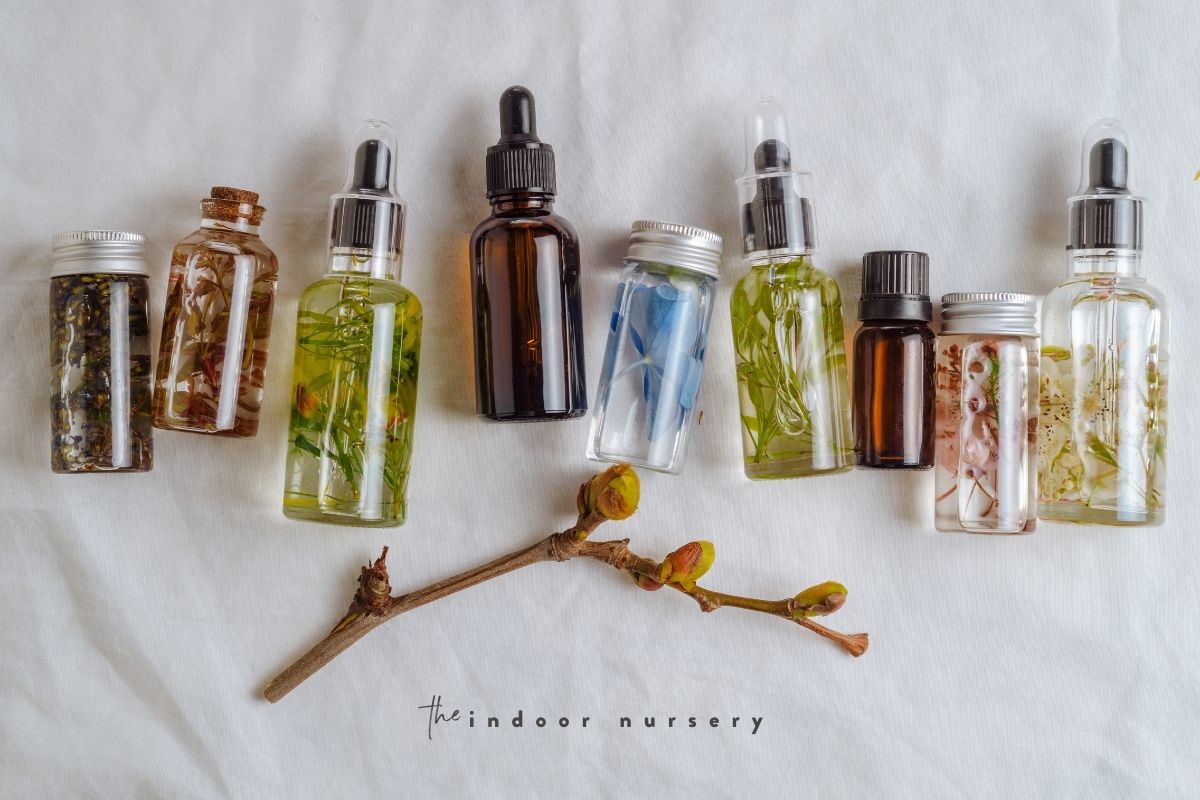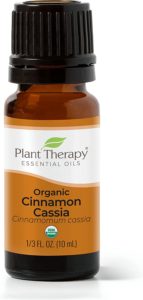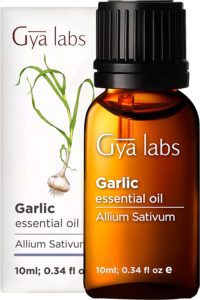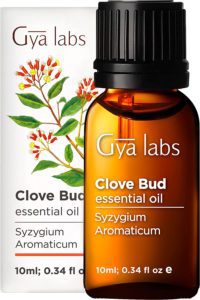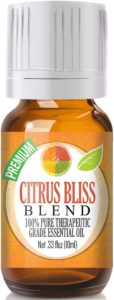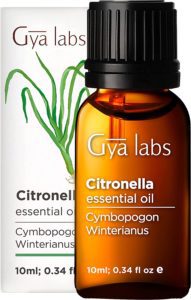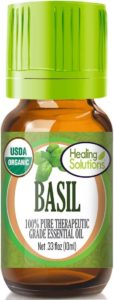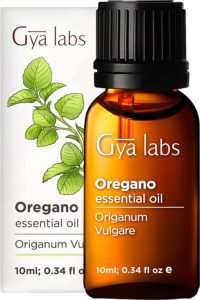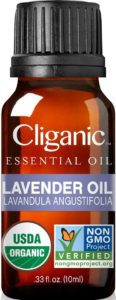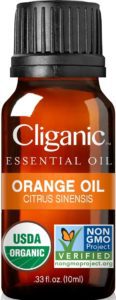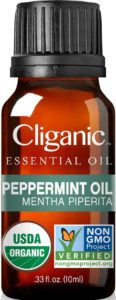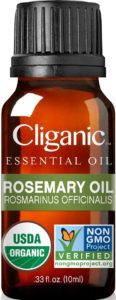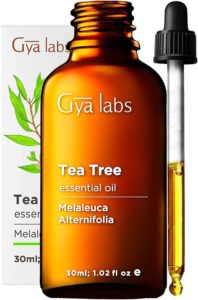Plant essential oils are natural substances that can be used in holistic aromatherapy, in natural beauty products, or…
…to improve the health of indoor and outdoor plants.
We know some essential oils for their ability to help with common gardening issues, such as controlling pests and improving plant growth.
There are many essential oils and it is important to choose the right one for the task at hand. Just like when working with a pure essential oil in beauty products and with aromatherapy, a little goes a long way. Too much and you can cause more harm than good.
Before using essential oils for anything on your plants, read through this entire post, including how to administer the essential oil. It’s important to use essential oils cautiously so that you don’t burn your plants.
For now, let’s dive into the science behind essential oils for plants, and find out which are the best essential oils for your indoor plants.
Best essential oils for plants and gardening
Plant essential oils are made with steam distillation, which extracts the active ingredients from the plant material. The distilled oil is a highly concentrated form of medicine or, when too much is used, poison.
Essential oils have been studied for years and continue to be studied because of their medicinal properties and for use as pesticides and herbicides in agriculture. In fact, plant material inspires modern medicine so the more we know about essential oils, the more advanced medicine and agriculture become.
Even cooler, many essential oils work synergistically with one another, making them even more effective than when used alone.
I’ve collected a list of different essential oils for plants from here and will summarize the relevant research findings that can help you choose the best essential oils for your houseplant needs.
Cinnamon essential oil
If your indoor plants have pests, then cinnamon essential oil is your pick. There have been tons of studies that look at Cinnamon as an all natural pesticide to be used in agricultural crops in place of chemical pesticides.
Cinnamon primarily acts as a repellent to garden pests, though higher doses have a biocidal effect, which prevents egg-laying.
Cinnamon also contains compounds that hinder both bacterial and fungal growth, making it a potential herbicide too.
This isn’t just cinnamon essential oil, either. Sprinkling cinnamon powder on your soil can stop and prevent fungal growth.
The spice is reportedly non-toxic to plants and does not seem to harm beneficial bacteria in the soil. This makes cinnamon a potentially useful tool for controlling fungal diseases as well harmful insects such as garden pests.
Garlic essential oil
Where cinnamon essential oil can help prevent and repel pests, garlic essential oil kills them. One study used garlic essential oil on larvae, pupae and adults of T. molitor, a mealworm beetle. They found that the garlic essential oil causes intoxication and necrosis at every stage of life of the pest.
Clove essential oil
Clove oil is one of the most powerful essential oils out there. Clove oil is so effective that, in treatment for some pests, it is more effective than neem oil. This essential oil not only is an insect repellent (including against mosquitos!) but also has antiviral and antifungal activity, antibacterial properties, anti-inflammatory activity, and is an antioxidant. Clove oil is a jack-of-all-trades kind of essential oil.
Citrus essential oil
This study found that citrus oil was highly effective against vineyard mealybugs. While these may not be the exact type of mealybug that you have on your indoor plants, they may have a similar reaction to citrus oil.
Citronella essential oil
Citronella is widely studied citronella as an insect repellent, most notably against mosquitos. Spritzing citronella on your plant leaves can help keep garden pests and fungus gnats away.
Basil essential oil
Basil essential oil is a repellent of common garden pests, especially fruit flies. However, this plant therapy only lasts for a short 2 hours and may require frequent application depending on how bad the infestation is.
Oregano essential oil
Oregano essential oil has been established as a powerful insecticide, though there is no mention of antifungal activity.
Lavender essential oil
Lavender oil is well-studied as an insecticide for flies, so it might be worth spraying a few drops throughout your home periodically if you have a lot of flies around. There isn’t much research on its use as an insecticide for plants, though.
Orange essential oil
Orange oil is a great fumigant against certain garden pests, most notably flies. Most studies look at citrus peels when examining the insecticidal effects of orange oil. Many of these properties are likely shared with lemon oil, in this case.
Peppermint essential oil
There have been rumblings of research about peppermint essential oil having antifungal activity, though some research has shown that peppermint is not effective against fungal growth. Studies like this one, however, find peppermint oil to be quite effective against certain types of insects.
Rosemary Essential Oil
Rosemary essential oil is known for its antimicrobial properties and has been shown to help prevent fungal growth in plants. One study published in the Journal of Agricultural and Food Chemistry found that rosemary oil was effective in inhibiting the growth of fungi in stored wheat grains. Another study published in the Journal of Essential Oil Research found that rosemary oil was effective against the fungus Fusarium oxysporum in vitro.
Rosemary oil has been shown to have insecticidal properties. A study published in the Journal of Economic Entomology found that rosemary oil was effective in controlling aphids on lettuce plants.
Tea Tree Essential Oil
Tea tree oil is also known for its antimicrobial properties and has been shown to help prevent the growth of bacteria and fungi in plants. The study mentioned above also found that tea tree oil was effective in inhibiting the growth of several types of fungi in stored wheat grains.
How to make essential oil plant spray
No matter what kind of essential oil plant spray you’d like to make for your indoor or outdoor plants though, the preparation and administration is roughly the same. You mostly just need a spray bottle, your chosen high-quality essential oil, and filtered/distilled water.
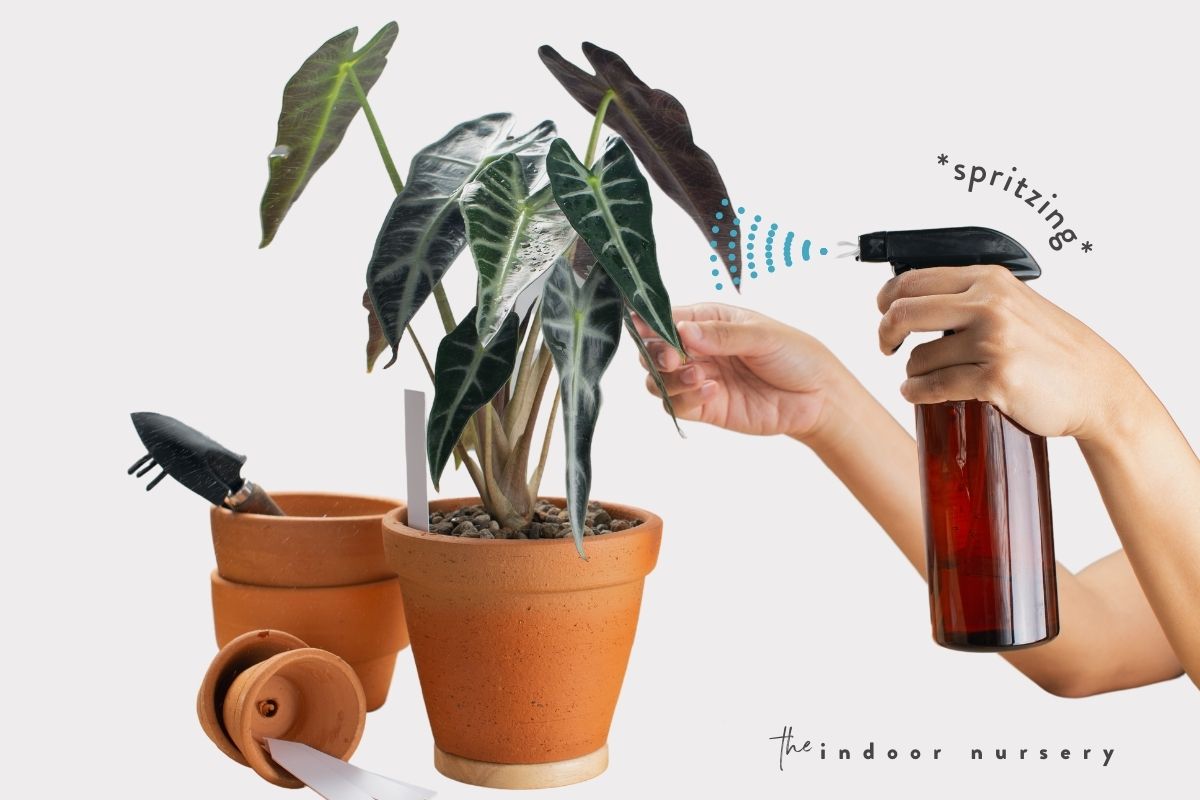
What you need:
- glass spray bottle
- filtered water
- chosen essential oils
Instructions:
- Mix the recommended amount per essential oil with filtered or distilled water in a glass spray bottle (about 500 ml / 16 oz).
- Spray on plant leaves from 6 inches away.
- Stop treatment if the plant shows signs of stress.
I recommend a glass spray bottle in a darker color. This way, the plant essential oils do not mix with the plastic like when using a plastic spray bottle. Plastic releases hundreds of pollutants into the liquid it contains, some of which could interact with the plant essential oils (and pollute your plant soil).
I also like the darker amber colored glass because it prevents too much sun and light from getting into the water. Algae more easily grows in water with ample light, so the amber color helps protect your mixture so that it will last longer.
When spraying your mixture, hold it about 6 inches away from your houseplant and mist lightly on one area of the houseplant to test.
If the infestation is terrible, then it’s possible that the plant is too weak to sustain strong treatment. Testing a small area and diluting your mixture further if you suspect that your plant may be sensitive to treatment.
Recipe: essential oil spray for plants
These are the most powerful all natural insecticidal recipes that you can make today. Clove oil is a popular choice among gardeners, so a simple clove oil spray may be enough. If not, then I also include a robust insecticidal recipe that combines the most effective essential oils against garden pests.
Clove oil insecticide recipe
Clove oil is more powerful than neem oil, so a simple mixture of just clove essential and filtered water will work here.
- 8-10 drops of clove essential oil
- filtered water
Essential oil pesticide recipe
All the ingredients in this recipe are general repellents and cinnamon oil is the most proven to be effective of the repellents. Garlic oil will help terminate any existing pests that are hiding under plant leaves or at the roots, like spider mites, mealybugs, scale, or larvae of any kind.
This is a powerful insect repellent, so use cautiously. Do not spray directly onto plant leaves. Spray from 6 inches away and let the mist lightly coat the plant leaves.
- 2 drops of cinnamon essential oil
- 2 drops of garlic essential oil
- 2 drops of clove essential oil
- 2 drops of oregano essential oil
- 2 drops of citronella essential oil
- filtered water
Essential oils for bugs on plants
Where there is direct research to support a treatment method for a specific kind of insect, I’ll list it here. Otherwise, my recommendations are based on the general insecticidal research per essential oil.
Essential oils for gnats
Citronella is effective against gnats and the rest of the ingredients are effective against flies. This spray is the ultimate fly repellent, or fumigant as they call it in the science world.
- 3 drops of citronella essential oil
- 2 drops of basil essential oil
- 2 drops of lavender essential oil
- 2 drops of orange essential oil
- filtered water
Essential oils for aphids
This study combined four essential oils together and found that the combination was 20 percent more effective as treatment for aphids than each of the essential oils could do on their own. The synergistic effect of the essential oils makes this spray so powerful.
- 2 drops of black pepper essential oil
- 2 drops of eucalyptus essential oil
- 2 drops of rosemary essential oil
- 2 drops of tea tree oil essential oil
- filtered water
Essential oils for mealybugs
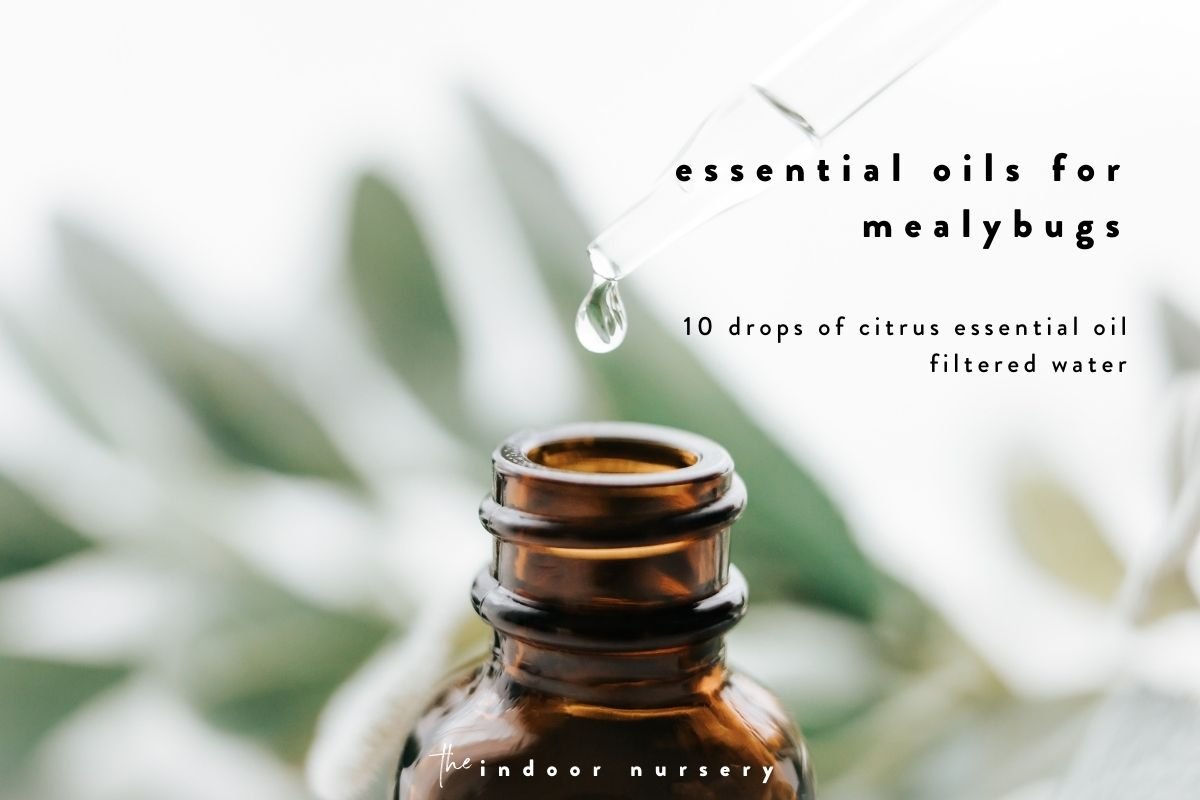
Citrus oil is effective against vineyard mealybugs and could be effective against the mealybugs on your potted plants. Try spraying this mixture on affected areas to begin with. Spray your plant every few days, skipping days if your plant responds negatively. If the mealybugs are especially bad, then they’re likely in the soil too. Spray around the base of the plant and sprinkle cinnamon powder on the soil and around the base of the plants.
- 10 drops of citrus essential oil
- filtered water
Essential oils for thrips
This scientific review found that plant essential oils are effective in treating thrips, most notably extracts of chili pepper, neem, orange peel with African curry leaf (Gmelina arborea L) or orange peel with Gmelina arborea L.
While these exact essential oils are difficult to find, I’ve listed below oils from the same families. Mix these essential oils together to treat your thrips.
- 1 drop of chili pepper essential oil
- 2 drops of neem oil
- 2 drops of orange essential oil
- 2 drops of curry leaf essential oil
- filtered water
Essential oils for brown scale
Scale is relatively easy to manage by introducing natural predators but you may want to try essential oils first. In that case, I recommend first removing all visible scale with a cotton swab dipped in rubbing alcohol. I also like to use a toothpick to remove the smaller scale, which are translucent and harder to see. Once everything is removed, then you can spray the plant leaves with this all natural repellent. The garlic oil will help terminate any remaining scale that you may have missed.
- 3 drops of cinnamon essential oil
- 3 drops of garlic essential oil
- filtered water
Essential oils for spider mites
Rosemary oil is the most effective type of essential oil against spider mites. Spray this mixture on plant leaves and around the base of the plant every few days. Stop treatment if you notice the plant becomes stressed.
- 10 drops of rosemary essential oil
- filtered water
Common questions
Are essential oils safe for plants?
Yes, in most cases. In fact, essential oils are studied for agricultural pest control, meaning that millions of dollars per year are spent on trying to understand how to make a bug spray that not only can repel bugs but also is safe for humans and plants. That being said, it is important to note that essential oils are extremely concentrated and the active constituents are more powerful per volume than you might find out in nature. So without proper dilution, you could accidentally harm your plants instead of helping them. Use these with caution and pay close attention to how your plants respond. Infested plants often have weakened immune systems and may not be able to handle strong treatment.
Will peppermint oil hurt plants?
Peppermint oil shows promise as an effective insecticide, so it definitely can work well with plants. The important thing is that you dilute the pure essential oil significantly, like around 10 drops per 16 ounces.
What essential oil kills fungus?
More About Pest Control
- How To Get Rid Of Scale On Plants
- The Best Neem Oil For Plants: Our Top Picks
- How to make homemade spray to keep cats from eating plants
- 12 essential oils for plants that treat pests, fungus, and more
- How to mix neem oil for plants with 3 simple ingredients
- What plants NOT to use neem oil on
- Most common cannabis pests and how to treat them
- Tags:
- pest control
- Pests

